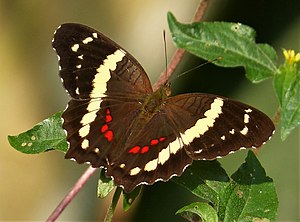Anartia fatima
| Anartia fatima | ||||||||||||
|---|---|---|---|---|---|---|---|---|---|---|---|---|

Anartia fatima |
||||||||||||
| Systematics | ||||||||||||
|
||||||||||||
| Scientific name | ||||||||||||
| Anartia fatima | ||||||||||||
| ( Fabricius , 1793) |
Anartia Fatima is occurring in North and Central America butterfly ( butterfly ) from the family of Nymphalidae (Nymphalidae).
description
butterfly
The wingspan of the moth is 60 to 70 millimeters. The basic color of the wings is black-brown to black. On the upper side of the fore wing, a white, sometimes yellowish band extends through the disk region , which continues on the hind wings. A few small whitish spots stand out near the apex . The hind wings show some distinctive red, sometimes orange spots. The tails at the anal corner are very short. All wing undersides show similar drawing elements as the upper sides, but these are paler and less pronounced.
Caterpillar, pupa
Adult caterpillars are blackish and have indistinct light longitudinal lines and points on the body. On each body segment there are strongly branched black or brown thorns, which are colored reddish brown at the base. On the head there are two thin, straight horns, which are thickened at the end like a piston. The tumbling doll is usually greenish in color and shows a few small dark points and a pale red cremaster and is slightly forked on the head. Occasionally there are also completely black pupae.
Distribution, occurrence and subspecies
The distribution area of Anartia fatima includes the southern regions of Texas as well as Mexico , Panama and Guatemala . In Colima it is represented by the subspecies Anartia fatima colima Lamas , 1995. Individual finds were reported from Kansas . The species prefers to colonize open, subtropical terrain and secondary forests .
Way of life

The moths fly in Texas for several consecutive generations throughout the year. Their frequency can vary greatly from year to year. They like to suck nectar, for example at Wandelröschen- ( Lantana ) or Ixora coccinea blossoms. Anartia fatima is in direct competition for flower nectar with other butterfly species as well as with different hummingbird species (Trochilidae) that inhabit the same territory, are viewed by them as intruders into their feeding area and that chase the butterflies away from the flowers. The male moths are extraordinarily good and persistent fliers, who cover distances of several hundred meters in search of the females. Females with white band markings on the wings are preferred for mating over specimens with yellowish band markings, probably on the assumption that they are younger and still unmated. Females with strong red markings on the hind wings are also preferred to those with orange markings. After mating, the females lay 200 to 400 eggs individually on the petals of the food plants, preferring fresh, tall plants. The caterpillars live on a variety of different acanthus plants (Acanthaceae), in Texas, for example, on Ruellien ( Ruellia ), in Central America also on rib ferns ( Blechnum ) and on Justicia or Dicliptera species.
Individual evidence
- ^ Butterflies and Moths of North America
- ↑ a b c d James A. Scott: The butterflies of North America. Stanford University Press, Stanford, California 1986, ISBN 0-8047-1205-0 , p. 275
- ↑ Markku Savela: Tanaecia Butler (1869) - distribution. In: Lepidoptera and some other life forms. Retrieved December 30, 2018 .
- ↑ Richard B. Primack and Henry F. Howe: Interference Competition Between a Hummingbird (Amazilia tzacatl) and Skipper Butterflies (Hesperiidae) , Association for Tropical Biology and Conservation Vol. 7, No. 1, 1975, pp. 55-58
- ↑ Thomas Emmel: Mate Selection and Balanced Polymorphism in the Tropical Nymphalid Butterfly, Anartia fatima , Society for the Study of Evolution 26 (1), 1972, pp. 96-107
- ^ Annette Aiello & Robert E. Silberlied: Orange Bands, a Simple Recessive in Anartia Fatima (Nymphalidar) Journal of the Lepidopterists' Society 32 (2), 1978, pp. 135-137
literature
- James A. Scott: The butterflies of North America. Stanford University Press, Stanford, California 1986, ISBN 0-8047-1205-0
Web links
- Lepiforum e. V. - Taxonomy and photos
- butterfliesofamerica - Butterflies of America
- bugguide.net - Iowa State University's Bug Guide
- eol.org - Encyclopedia of Life
